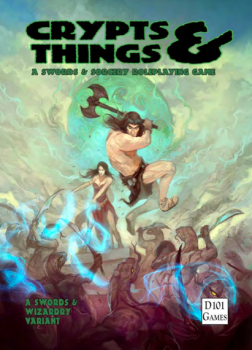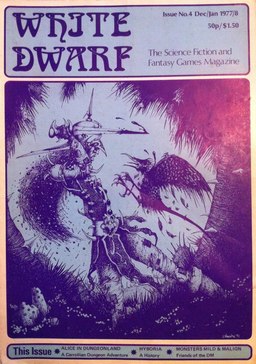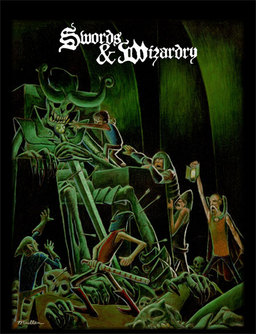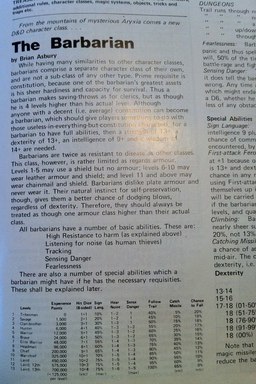Adventure in a Place of Unholy Shadows: A Review of Crypts and Things
 Back in the 70s, when I first started playing Dungeons and Dragons (D&D), I spent a long time wanting a ruleset that would let me recreate the sort of sword and sorcery that I was reading back then.
Back in the 70s, when I first started playing Dungeons and Dragons (D&D), I spent a long time wanting a ruleset that would let me recreate the sort of sword and sorcery that I was reading back then.
I wanted to play a game that caught the atmosphere of Robert E Howard’s Conan, Karl Edward Wagner’s Kane, or Fritz Leiber’s Fafhrd and Grey Mouser stories. I wanted to adventure in a place of unholy shadows, where magic was scary and thrilling and men with swords sought lost treasures in glittering towers where old gods and dark secrets waited.
Clearly, D&D was not quite what I was looking for. The white box contained an unholy mishmash of Tolkien, bits of medieval history, and a weird variation of Vancian magic from the Dying Earth which, while awesomely powerful, was not very scary or, well, magical. Magic items were as common as if they came in cereal boxes. And what was with it with those cleric guys and the undead?
The setting of D&D did not look like any fantasy world I had read about, but it was clearly influenced by a number of them. There were thieves that might have been Fafhrd and the Grey Mouser. There was a barbarian character class in an issue of White Dwarf that might, if you squinted, have resembled something like Conan.
But D&D did not quite hit the mark. There were also elves and halflings and dwarves and all manner of other things that did not exist in the S&S universes of my particular dreams. There were echoes of Howard and Leiber and Clark Ashton Smith, but they were smudged over with bits of Tolkien and a kind of high fantasy.
I did what everybody else was doing, and home-brewed my own rules. But they were clunky and still never quite hit the mark and hey, I was not at all confident in my game design skills. I wanted officially sanctioned rules if I could get them.

What I would not have given to be able to purchase a set of rules off the shelf and drop myself and my players into a world like Hyboria or Nehwon or Zothique. Now, only 35 years or so later, and courtesy of the Old School Renaissance (OSR), I finally have access to just such a thing.
Crypts and Things (C&T) from D101 Games is a set of rules that would not only fulfil the expectations of my teenage self, but would have been instantly familiar to him as well. It’s based on Swords and Wizardry, a well-regarded OSR game that is a very close clone of those old D&D rules.
At this point, you’re probably thinking, I’m very happy for you and the fulfilment of your youthful dreams, Bill, but why the hell should I care? Because Crypts and Things is a very good set of Sword and Sorcery rules that sits right on top of a game engine that, if you are familiar with role-playing games at all, you probably already have a working knowledge of. Not only that, it is a stripped down rule system, which plays fast and does a brilliant job of recreating the tropes of the genre.
Crypts and Things is set in a dark and dangerous world where casting magic might cost you your soul or your sanity. There are no clerics. The default setting is a world of humans and hidden monsters and the sort of gods and demons whose attention you really, really don’t want to catch.
There are only four classes. Warriors, barbarians, thieves, and sorcerers. They all fit the sword and sorcery archetype very well. The barbarian is actually based on the one in that old White Dwarf article, but done more slickly. Hit points don’t represent actual physical damage; they represent shock, pain, and loss of the will to fight and you can regain them with a night’s sleep or even with a swig of strong liquor (d4 points once per day), a nice genre touch.
 Actual physical damage only starts when your hit points are gone and comes directly off your constitution score. That sort of hurt takes a lot longer to heal. It’s a nice system which increases survivability greatly in a world where healing magic is not common and magic items are rare and always come with a downside.
Actual physical damage only starts when your hit points are gone and comes directly off your constitution score. That sort of hurt takes a lot longer to heal. It’s a nice system which increases survivability greatly in a world where healing magic is not common and magic items are rare and always come with a downside.
The classes all have their advantages. The barbarian has a first attack ferocity bonus and a lot of ranger-like tracking and outdoor abilities. It fits the S&S stereotype to a tee. I could easily fulfill my youthful desire to play Clone-an with it. The fighter gets to pick some special abilities, such as different fighting styles or being a berserker, to make each a little different.
The thief does things in the manner that should be familiar to fans of D&D and the Grey Mouser alike. The sorcerer is a bit physically stronger than his D&D equivalent, with a d6 hit points and the ability to use most weapons and armour. He gets a −1 penalty on weapon damage, but you can’t pick him out in a crowd because he is wearing robes, a pointy hat, and carrying a dagger.
Magic itself uses most of the spells from the D&D books. There is no distinction between clerical magic and arcane magic. Instead there is white magic, grey magic, and black magic. White magic is mostly healing, detection, and protection. There are no penalties for using it. Grey magic is mostly illusion and stuff that lets you work your will on other people like charm person. It costs you hit points to use. Black magic is all the destructive, dark stuff and it’s going to cost you sanity and eventually your status as a player character if you use too much of it. It’s still basic D&D magic, but it is used flavorfully.
The saving throw system is simple and elegant. Everyone gets one basic saving throw based on their class and level. This is modified by the appropriate attribute bonus— Dexterity for saves that require physical quickness, Wisdom for willpower saving throws and so on.

Even more elegant is the use of this basic mechanic for almost any sort of skill roll. Want to try talking someone into something? Make a save and modify it by your Charisma bonus plus any modifier the DM gives you for role-playing. It’s simple, it’s easy to remember and it works. At first, I thought it was just too simple, but in play it was a pleasure to use.
There are many other things I like about C&T. Everybody gets to backstab, not just thieves, because it’s that sort of world and that sort of genre. The selection of monsters is atmospheric and genre relevant (Serpent Men, for example!), no orcs or goblins. There’s a nice random table on which you get three rolls that lets you customise your background. You can, for example, find out that your character was a former gladiator, pirate, or temple slave for the Other Gods and get bonuses for it. The default setting Zarth was clearly written by someone who loves the genre. Magic items are rare and always come with some sort of downside. The game is sword and sorcery, not just an approximation of it.
Is there anything I disliked about C&T? Well, there are lots of To Hit tables divided by class. I found myself thinking, come on, even back in the seventies we had heard of THACO, but at the end of the section there is the simple formula you need for calculating your hit rolls. The tables are just there for completeness and because, well, they are Old School.
The book is short (151 pages), well if sparsely illustrated, and well worth your time if you have any sort of interest in S&S gaming. It’s available as a downloadable PDF from DrivethroughRPG at a cost of $12.
Awesome. Thanks to your article, I just downloaded this to supplement my SWORDS OF AI HANLO
Awesome! Thanks to your article, I just downloaded this to supplement my SWORDS OF AI HANLO campaign. (It’s what I called “Modified AD&D because I seriously modified the 1st Edition rules.) It’s set in the world of Darrell Schweitzer’s ECHOES OF THE GODDESS/THE SHATTERED GODDESS books. It’s actually amazing how much the C&T rules have hit on the same ideas I did when revising the old-school rules (specifically, the whole idea of Hit Points as superficial damage and Con as true damage). From CRYPTS & THINGS I’ll mainly be using the magical items, new creatures, and various elements that fit quite well into what I’m doing wih AI HANLO (and earlier ran as AGE OF KULL). Very cool stuff!
Thanks, John! Sorry to take so along about responding. I was over in the UK for Gamesday and without internet access. C&T is a great game. I know the CON/HP thing works because I used it for years– got it from another early WD article. Also used HP as spell points. Your campaign sounds great. Always had a soft spot for Kull. The Shadow Kingdom is one of my all-time favourite REH stories. The Serpent Men are among Howards’s coolest and scariest villains.
[…] Adventure in a Place of Unholy Shadows: A Review of Crypts and Things […]
[…] William King noted last month in his review of Crypts and Things, as popular and flexible as D&D was, it wasn’t ideally suited for […]
[…] three colours of magic, each with their own costs. Although based on earlier reviews (e.g. here and here) I had certain expectations and there have clearly been a few changes in the “remastering”. It […]
I was looking for more lore and information that I could put into a grittier game than 5e would allow. I do come from AD&D, the first edition, and also played some with the second. I heard about something in the second edition that I never got to play called Dark Sun. It is a little grittier.
Anyway, I wanted a book to help me come up with some ideas, and though Crypts and Things is a game in its own right, I like it as a sourcebook. I’m using its lore, but unfortunately not its map. I decided to go with Newhon for my continent for players to explore.
Thanks for your review, I’m pretty sure it will offer great fun. Intriguing monsters and treasures. I’ve already used Red Rock Warriors in the campaign.